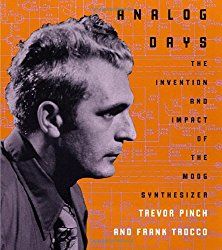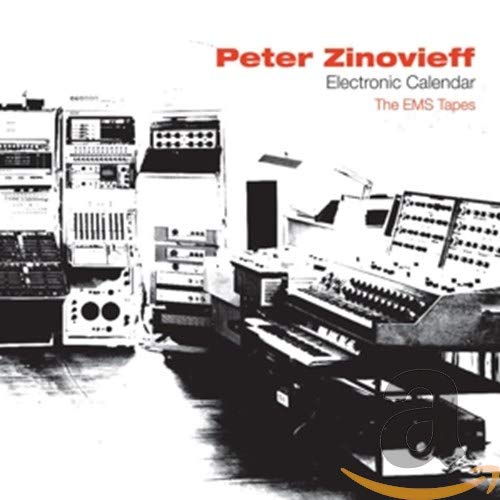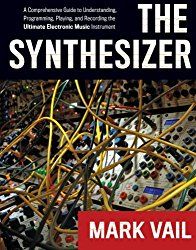Note: Auction links are affiliate links for which the site may be compensated.
video upload by Instrument Attic
via this eBay listing
"The 1966 Johnson Intonation Trainer is a rare and intriguing instrument developed by the E.F. Johnson Company of Waseca, Minnesota. Originally designed to assess pitch-matching and pitch-discrimination abilities, this device has garnered attention for its unique features and potential applications in modern music production.  
One of the standout characteristics of the Johnson Intonation Trainer is its full polyphony, allowing all 37 keys to be played simultaneously. Each key is associated with its own oscillator, enabling microtonal adjustments and the exploration of unconventional scales and tunings. The instrument offers four distinct voicing options, ranging from basic sine waves to more complex, reedy tones. Additionally, the “Scale Selector” switch provides a choice between standard tempered tuning and a tunable mode, with individual “Tunable Scale Controls” corresponding to each note on the keyboard for precise pitch calibration.    
Housed in a robust fiberglass case, the Intonation Trainer features a built-in speaker, though it can also be connected to external amplifiers or mixers via standard 1/4” outputs. Some units include a vibrato effect, though functionality may vary between models. 
In contemporary settings, the Johnson Intonation Trainer has found a niche among experimental musicians and sound designers. Its ability to produce rich drones and facilitate microtonal exploration makes it a valuable tool for creating unique sonic textures. The instrument’s vintage analog circuitry imparts a distinctive warmth and character that is highly sought after in modern music production.
Due to limited production and the passage of time, functional units of the Johnson Intonation Trainer are exceedingly rare. Finding one in full working condition, complete with original documentation, is a remarkable discovery for collectors and enthusiasts alike. The scarcity of this instrument, combined with its unique capabilities, underscores its status as a treasured piece of audio history."
via this eBay listing
"Made in 1966 in Waseca, Minnesota by the E. F. Johnson Company. Originally designed as an ear training and intonation device, but in practice it is a unique fully polyphonic analog synthesizer with extensive tuning control. Very few were made, and surviving examples in this condition are vanishingly rare.
Showing posts sorted by date for query Instrument Attic. Sort by relevance Show all posts
Showing posts sorted by date for query Instrument Attic. Sort by relevance Show all posts
Saturday, September 06, 2025
Wednesday, August 20, 2025
Korg ARP Odyssey Rev3 37-Slim Key Duophonic Analog Synthesizer
Note: Auction links are affiliate links for which the site may be compensated.
via this eBay listing
"The synthesizer and case are in Mint Condition, and barely used. Includes Power Supply, Case, Manual, Power Supply. Original box does have minor water damage due to stored in attic where rain leaked in.
The Korg ARP Odyssey Rev3 37-Slim Key Duophonic Analog Synthesizer is a professional-grade keyboard synthesizer designed for musicians and producers. With its slim keys and duophonic design, this synthesizer provides a unique and expressive sound experience. As an analog synthesizer, it offers warm and authentic tones that can be further manipulated and crafted to create custom sounds. The Korg brand is well-known for its quality and reliability in the world of musical instruments and gear, making this synthesizer a popular choice for those seeking a versatile and high-performance instrument for their music production needs."
via this eBay listing
"The synthesizer and case are in Mint Condition, and barely used. Includes Power Supply, Case, Manual, Power Supply. Original box does have minor water damage due to stored in attic where rain leaked in.
The Korg ARP Odyssey Rev3 37-Slim Key Duophonic Analog Synthesizer is a professional-grade keyboard synthesizer designed for musicians and producers. With its slim keys and duophonic design, this synthesizer provides a unique and expressive sound experience. As an analog synthesizer, it offers warm and authentic tones that can be further manipulated and crafted to create custom sounds. The Korg brand is well-known for its quality and reliability in the world of musical instruments and gear, making this synthesizer a popular choice for those seeking a versatile and high-performance instrument for their music production needs."
Friday, November 17, 2023
Minimoog Model D SN 4522 w/ MiniMoog Sound Charts Book
Monday, September 21, 2015
Light In The Attic Announces Jodorowsky's Dune Original Motion Picture Soundtrack by Kurt Stenzel
Published on Sep 16, 2015 Light In The Attic Records
Be sure to see my post on The Synths of Jodorowsky's Dune with some words from Kurt Stenzel on the synths used in the soundtrack.
"This track is from Light In The Attic Records' release of Kurt Stenzel's original score to the documentary 'Jodorowsky's Dune.' It is available for purchase on vinyl & CD here: http://bit.ly/1iMSNRE.
Available: November 13th, 2015
This is the soundtrack to the story about the greatest film that never was.
Jodorowsky’s Dune tells the tale of cult filmmaker Alejandro Jodorowsky’s unsuccessful attempt to adapt Frank Herbert’s classic sci-fi novel, Dune, to the big screen. Composer Kurt Stenzel gives life to a retro-futuristic universe as fantastic as Jodorowsky’s own vision for his Dune–a film whose A-list cast would have included Salvador Dalí, Orson Welles, and Mick Jagger in starring roles and music by psychedelic prog-rockers Pink Floyd.
Building upon director Frank Pavich’s idea for a score with a 'Tangerine Dream-type feel,' Stenzel lays out a cosmic arsenal of analog synthesizers that would make any collector green at the gills: among other gems are a rare Moog Source, CZ-101s, and a Roland Juno 6, as well as unorthodox instruments like a toy Concertmate organ and a Nintendo DS. 'I also played guitar and did vocals,' says Stenzel, 'some chanting… and some screaming, which comes naturally to me.' The score also features narration by Jodorowsky himself. As Stenzel notes, 'Jodo’s voice is actually the soundtrack’s main musical instrument–listening to him was almost like hypnosis, like going to the guru every night.'
This highly-anticipated soundtrack LP was sequenced and mixed by Stenzel with the listener in mind and flows through a 'four-sides' LP approach. 'I wanted it to play like the records I grew up with, where every side was a journey.'
First time release
Liner notes by composer Kurt Stenzel
Original artwork by Nick Stewart Hoyle
2xLP housed in a deluxe gatefold Stoughton tip-on jacket
Includes download card for full album
LITA.net pre-order edition:
- 'Cosmic Swirl' Wax limited to 1,000 copies (2 per customer)
- Silver foil numbered jacket
- Includes folded 27″×40″ poster with artwork by Nick Stewart Hoyle"
Soundtrack Listing:
Wednesday, May 20, 2009
More info on the Aries System Modular
 via kkissinger on this electro-music.com thread (see the thread for updates):
via kkissinger on this electro-music.com thread (see the thread for updates):"After 33 years, my Aries still works to specification.
They used Allen-Bradley pots and they have not become scratchy after all these years. I have had to replace a bypass switch on the Phaser and have, in the past, had to replace the big capacitors on the power supply.
The oscillators are extremely stable.
I have made a few mods to the synth. I dioded the gate and trigger inputs to the envelope generators to prevent "backfeeding" of trigger and gate signals. I've added a Paia MIDI-to-CV converter to it.
The only module that I don't (and have never liked) is the output module because it is too noisy. However, not a big deal because I always just fed the output from the end of my signal chain (generally a VCA) directly to my recorder and/or amplifier-speakers. I want to rebuild the output and power module to bring the level up to +4dbv balanced output for compatability with the rest of my studio.
The keyboards have also held up very well. The contacts are self-wiping gold-plated contacts that never need cleaning. If a contact is intermittent then all one has to do is repeat the note a few times (this happens on some of the less-used high notes).
The Pitch-to-Voltage converter is really an awesome module that works very well.
How does it sound? Well, if you like Moog or Arp Synthesizers, then you probably would like the Aries.
If you purchase one, make sure that it comes with all the schematics. Since it is a kit synthesizer, the quality may vary depending on the skill of the builder.
Also, I power up my Aries on a regular basis -- this is important. An instrument that has sat in an attic for thirty years may require a major restoration effort.
The Aries is a precision instrument -- for example, if you want to do classical transcriptions, then the keyboard action and tuning accuracy permits this kind of use. The five-octave keyboard was quite a luxury in the mid 1970's. They utilize 1% metal film resisters across the keyboard voltage divider. The keyboards are two-voice capable. The voice output produces a voltage that corresponds to the lowest note that is pressed. The aux-voice output produces a voltage that is the difference between the highest and lowest note. Thus, to track the highest note one must sum the Voice and Aux Voice voltages.
The control voltages are standard 1v/Octave. The gates, triggers, VCO, and LFO voltage are all 10v peak-to-peak. Thus, the Aries modules are compatable with modern equipment.
I just posted some looped/improvised tracks at http://kevinkissinger.com/ariesinfo.shtml. You will also see a number of multi-track works and other Aries synth tracks from my tape "archives" there.
On my theremin page, I used the Aries for parts of the Franck "Prelude, Fugue, and Variation".
I'm not entirely sure -- from what I've seen my collection of Aries tracks may be one of the largest that is available all in one place.
We are holding a regional electro-music festival here (near Kansas City) in July. I plan to have the Aries there in the exhibition space and may use it for a set. Would be great to have you attend and you will get to experience the Aries and a lot of other homebuilt/DIY equipment there. Smile
Here is a link to the Call for Participation:
http://electro-music.com/forum/topic-32546.html"
Monday, March 13, 2006
The "Can't-Resist-A-Sizer"
 The Eaton-Moog Multiple-Touch-Sensitive Keyboard. It has two rows of keys.
The Eaton-Moog Multiple-Touch-Sensitive Keyboard. It has two rows of keys.Update: Found a video link on The Ledger.
What if this is Moog's new announcement? Probably not, but who knows... ; )
Note: The sound of it reminds me of the Novachord Restoration Project.
Title link takes you to the full article on the Lost Eaton-Moog Synth Keyboard.
Note that Eaton will be performing in New York on March 19:
"Eaton's works will be featured in a concert at 8 p.m. Sunday, March 19, at St. Stephen's Church, 120 West 69th St. in New York. The event is a collaboration of the New York Composers Circle and ModernWorks. The suggested donation is $15."
Some bits pulled from the article:
"It's called the Eaton-Moog Multiple-Touch-Sensitive Keyboard, a name only an engineer could love. That's fine with Eaton. He and Moog (rhymes with "vogue") spent four decades honing a tool for virtuosos, not a toy."
"It's very difficult to play. But an instrument should be difficult to play. That's the only way to master musical materials, by overcoming these difficulties," says Eaton, 70, surrounded in his cramped attic studio by upright pianos, ancient computers and programs and scores from his 20 operas."
"What is unique -- and challenging -- about the Eaton-Moog keyboard is how many ways each key can be programmed to respond. How far you depress a key matters. The actual area covered by your finger changes the sound. Sliding your finger across a key's length or width can approximate, say, a vibrato effect on a violin string. How hard you push a depressed key matters, too."
"Eaton jokingly dubs this keyboard the "Can't-Resist-A-Sizer."
"How does it sound?
Think theremin -- from quavering soundtracks of cheesy sci-fi movies -- crossed with a baseball organ. Throw in some psychedelic chemicals, and you begin to get the idea."
Lost Eaton-Moog Synth Keyboard
Interesting. Synthtopia has a post up on a Lost Eaton-Moog Synth Keyboard. They are asking if you know more about it, to contact them. I wonder how this compares to the Haken Continuum. I wonder if John Eaton knows about it.
"Composer John Eaton is waiting for someone to develop a "lost" instrument, the Eaton-Moog Multiple-Touch-Sensitive Keyboard. The keyboard design was a collaboration between Eaton and Robert Moog, and features keys with enhanced capabilities, enabling new methods of touch control of synthesizers.
The [device] is "the world's most sensitive musical instrument next to the human voice," according to Eaton. "Playing it is a kind of combination of playing a a very sensitive stringed instrument and playing a keyboard instrument."
The keys on the 49-note keybaord respond to five motions: the distance a key is depressed; the finger's front and back position and motion on each key; the finger's side-to-side position and motion on each key; the total area a flattened finger covers on each key; and pressure on a key after it is depressed fully.
These five, fully independent controls send signals in digital streams of numbers to a computer, which routes the signals to affect any possible aspect of musical continuity desired--loudness; vibrato; tremolo; reverb; tone color or instrumental change; the speed, pitch, and any other application that can be dealt with by a modern sound synthesizer or sound-generating computer program.
The prototype now lives in Eaton's attic, according to an article in the NJ State Ledger."
"Composer John Eaton is waiting for someone to develop a "lost" instrument, the Eaton-Moog Multiple-Touch-Sensitive Keyboard. The keyboard design was a collaboration between Eaton and Robert Moog, and features keys with enhanced capabilities, enabling new methods of touch control of synthesizers.
The [device] is "the world's most sensitive musical instrument next to the human voice," according to Eaton. "Playing it is a kind of combination of playing a a very sensitive stringed instrument and playing a keyboard instrument."
The keys on the 49-note keybaord respond to five motions: the distance a key is depressed; the finger's front and back position and motion on each key; the finger's side-to-side position and motion on each key; the total area a flattened finger covers on each key; and pressure on a key after it is depressed fully.
These five, fully independent controls send signals in digital streams of numbers to a computer, which routes the signals to affect any possible aspect of musical continuity desired--loudness; vibrato; tremolo; reverb; tone color or instrumental change; the speed, pitch, and any other application that can be dealt with by a modern sound synthesizer or sound-generating computer program.
The prototype now lives in Eaton's attic, according to an article in the NJ State Ledger."
HOME













© Matrixsynth - All posts are presented here for informative, historical and educative purposes as applicable within fair use.
MATRIXSYNTH is supported by affiliate links that use cookies to track clickthroughs and sales. See the privacy policy for details.
MATRIXSYNTH - EVERYTHING SYNTH













© Matrixsynth - All posts are presented here for informative, historical and educative purposes as applicable within fair use.
MATRIXSYNTH is supported by affiliate links that use cookies to track clickthroughs and sales. See the privacy policy for details.
MATRIXSYNTH - EVERYTHING SYNTH



























